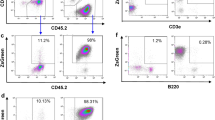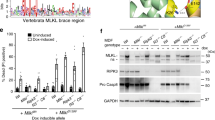Abstract
THE study of leukaemia viruses was until recently greatly hampered by the lack of cell cultures capable of propagating such viruses, but several cultures have now been found which support the replication of murine leukaemia virus. One of these cultures (JLS V6) originated from a mixture of BALB/c mouse spleen and thymus cells. Exposure of this culture to a cell free extract of leukaemic spleen from mice infected with Rauscher leukaemia virus (RLV) has resulted in a chronically infected culture (JLS V5) which continually propagates Rauscher virus1. In our laboratory, gross cytopathic effects are seen in such infected cells2. The infected cultures (JLS V5) also show a marked increase in mucopolysaccharide and a concomitant loss of contact inhibition, which results in a transformed “criss-cross” growth pattern. Such infected transformed cells have an enhanced tumorigenicity when they are injected into newborn BALB/c mice. The resultant tumours are rich in mucopolysaccharide and are classified as myxofibrosarcomata3. Tests to detect the presence in the infected cultures of other murine viruses to which the observed alterations might be attributable have been negative3. Moreover, newborn mice from mothers immunized with formalized extracts of spleen infected with RLV are resistant to challenge with the transplantable myxofibrosarcoma cells, whereas newborn mice from mothers immunized with extracts of normal spleen tissue show no such resistance4. The uninfected control cells (JLS V6) do not show gross cytopathic effects or transformation and are much less tumorigenic. Furthermore, the tumours that do result from injection of non-infected control cells are classified as spindle-cell sarcomata3.
This is a preview of subscription content, access via your institution
Access options
Subscribe to this journal
Receive 51 print issues and online access
$199.00 per year
only $3.90 per issue
Buy this article
- Purchase on Springer Link
- Instant access to full article PDF
Prices may be subject to local taxes which are calculated during checkout
Similar content being viewed by others
References
Wright, B. S., and Lasfargues, J. C., J. Nat. Cancer Inst., 35, 319 (1965).
Tyndall, R. L., Vidrine, J. G., Teeter, E., Upton, A. C., Haris, W. W., and Fink, M. A., Proc. Soc. Exp. Biol. and Med., 119, 186 (1965).
Tyndall, R. L., Teeter, E., Otten, J. A., Bowles, N. D., Vidrine, J. G., Upton, A. C., and Walbarg, jun., H. E., Intern. J. Cancer, 1, 565 (1966).
Tyndall, R. L., Otten, J. A., Teeter, E., and Bowles, N. D., Proc. Soc. Exp. Biol. and Med. (in the press, 1967).
Markert, C. L., and Hunter, R. L., J. Histochem. Cytochem., 7, 42 (1949).
Allen, R. C., Popp, R. A., and Moore, D. J., J. Histochem Cytochem., 13, 249 (1965).
Allen, R. C., and Jamieson, G. R., Anal. Biochem., 16, 450 (1966).
Sheinin, R., Virology, 25, 47 (1966).
Kit, S., Dubbs, O. R., de Torres, R. A., and Melnick, J. L., Virology, 28, 453 (1966).
Zeigel, R. F., Tyndall, R. L., O'Connor, T. E., Teeter, E., and Allen, B. V., Nat. Cancer Inst. Monog., 22, 237 (1966).
Author information
Authors and Affiliations
Rights and permissions
About this article
Cite this article
TYNDALL, R., ALLEN, R. Altered Esterase Zymograms associated with Infection with Leukaemia Virus. Nature 215, 984–985 (1967). https://doi.org/10.1038/215984a0
Received:
Issue Date:
DOI: https://doi.org/10.1038/215984a0
This article is cited by
-
Isoenzymes and histochemistry of non-specific esterases in normal and cancerous skin
The Histochemical Journal (1970)
Comments
By submitting a comment you agree to abide by our Terms and Community Guidelines. If you find something abusive or that does not comply with our terms or guidelines please flag it as inappropriate.



